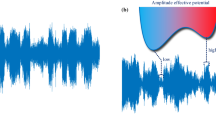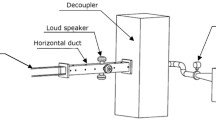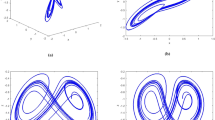Abstract
Varying one of the governing parameters of a dynamical system may lead to a critical transition, where the new stable state is undesirable. In some cases, there is only a limited range of the bifurcation parameter that corresponds to that unwanted attractor, while the system runs problem-less otherwise. In this study, we present experimental results regarding a thermoacoustic system subject to two consecutive and mirrored supercritical Hopf bifurcations: the system exhibits high-amplitude thermoacoustic limit cycles for intermediate values of the bifurcation parameter. Changing quickly enough the bifurcation parameter, it was possible to dodge the unwanted limit cycles. A low-order model of the complex thermoacoustic system was developed, in order to describe this interesting transient dynamics. It was afterward used to assess the risk of exceeding an oscillation amplitude threshold as a function of the rate of change of the bifurcation parameter.










Similar content being viewed by others
Notes
\(P_\infty (A;\, t=0)=\mathcal {N}A\exp {[{4\omega _{0}^{2}}/{\varGamma }({\nu _0 A^{2}}/{2}-{\kappa A^{4}}/{32})]}\), where \(\nu _0=\nu (t=0)\) and \(\mathcal {N}\) is a normalization constant. See [46] for more details.
Abbreviations
- t :
-
Time (s)
- \(T_{\text {r}}\) :
-
Ramp duration (s)
- R :
-
Ramp rate
- \(T_\nu \) :
-
Characteristic oscillation growth time (s)
- \(\dot{m}_{\text {air}}\) :
-
Air mass flow rate (kg/s)
- \(\dot{m}_{\text {ng}}\) :
-
Natural Gas mass flow rate (kg/s)
- \(\phi \) :
-
Equivalence ratio
- p :
-
Acoustic pressure (bar)
- A :
-
Acoustic oscillation random amplitude (bar)
- \(\varphi \) :
-
Oscillation random phase (rad)
- \(\omega \) :
-
Angular frequency (rad/s)
- \(S_{pp}\) :
-
Power spectral density of the signal p (\([p]^2\) Hz\(^{-1}\))
- P(X):
-
Probability density function (PDF) of a stochastic variable X\([X]^{-1}\)
- \(P_{\text {max}}\) :
-
\(={\text {max}}_X\{P(X)\}\)
- \(\omega _0\) :
-
Oscillator natural angular frequency (rad/s)
- \(\nu \) :
-
Linear growth rate (rad/s)
- \(\nu _{\text {min}}\) :
-
Minimum \(\nu \) of the range (rad/s)
- \(\nu _{\text {max}}\) :
-
Maximum \(\nu \) of the range (rad/s)
- \(\kappa \) :
-
Cubic saturation constant (rad/s \([p]^{-2}\))
- \(\xi (t)\) :
-
White noise process ([p]/s\(^2\))
- \(\varGamma \) :
-
Noise intensity
- \(A_{\text {th}}\) :
-
Threshold amplitude
- \(\langle A(t) \rangle \) :
-
Expected value of A(t)
- \(A_\infty (\dot{m}_{\mathrm {air}})\) :
-
\(=\int _0^\infty AP_\infty (A;\,\dot{m}_{\mathrm {air}})\text {d}A\)
- \(A_{\text {min}}\) :
-
\(={\text {min}}\{A_\infty \}\) (when \(\nu =\nu _{\text {min}}\))
- \(A_{\text {max}}\) :
-
\(={\text {max}}\{A_\infty \}\) (when \(\nu =\nu _{\text {max}}\))
- \(\Pr _{\text {nc}}(t)\) :
-
\(=\int _0^{A_{\text {th}}}P(A;\,t)\text {d}A\)
- \(\Pr _{\text {d}}\) :
-
\(=\Pr _{\text {nc}}(T_{\text {r}})\) Dodge probability
- \(\varDelta t_{\text {th}}\) :
-
Time interval spent over the threshold \(A_{\text {th}}\)
- E :
-
\(=\int _{\varDelta t_{\text {th}}}{\langle A(t) \rangle }^2\text {d}t\) Mean energy
References
Ashwin, P., Wieczorek, S., Vitolo, R., Cox, P.: Tipping points in open systems: bifurcation, noise-induced and rate-dependent examples in the climate system. Philos. Trans. R. Soc. A 370, 1166–1184 (2012)
Kuznetsov, Y.A.: Elements of Applied Bifurcation Theory, vol. 112. Springer, Berlin (2013)
Hoegh-Guldberg, O., Mumby, P.J., Hooten, A.J., Steneck, R.S., Greenfield, P., Gomez, E., Harvell, C.D., Sale, P.F., Edwards, A.J., Caldeira, K., et al.: Coral reefs under rapid climate change and ocean acidification. Science 318(5857), 1737–1742 (2007)
Bosi, S., Desmarchelier, D.: Limit cycles under a negative effect of pollution on consumption demand: the role of an environmental Kuznets curve. Environ. Resour. Econ. 69(2), 343–363 (2018)
Lenton, T.M., Held, H., Kriegler, E., Hall, J.W., Lucht, W., Rahmstorf, S., Schellnhuber, H.J.: Tipping elements in the Earth’s climate system. Proc. Natl. Acad. Sci. 105(6), 1786–1793 (2008)
Kühnen, J., Braunshier, P., Schwegel, M., Kuhlmann, H.C., Hof, B.: Subcritical versus supercritical transition to turbulence in curved pipes. J. Fluid Mech. 770, 12 (2015)
Scheffer, M., Carpenter, S.R., Lenton, T.M., Bascompte, J., Brock, W., Dakos, V., Van de Koppel, J., Van de Leemput, I.A., Levin, S.A., Van Nes, E.H., et al.: Anticipating critical transitions. Science 338(6105), 344–348 (2012)
Kuehn, C.: A mathematical framework for critical transitions: bifurcations, fast-slow systems and stochastic dynamics. Physica D: Nonlinear Phenom. 240(12), 1020–1035 (2011)
Karnatak, R., Kantz, H., Bialonski, S.: Early warning signal for interior crises in excitable systems. Phys. Rev. E 96(4), 042211 (2017)
Dakos, V., Carpenter, S.R., van Nes, E.H., Scheffer, M.: Resilience indicators: prospects and limitations for early warnings of regime shifts. Philos. Trans. R. Soc. B Biol. Sci. 370(1659), 20130263 (2015)
Drake, J.M., Griffen, B.D.: Early warning signals of extinction in deteriorating environments. Nature 467(7314), 456 (2010)
Ritchie, P., Sieber, J.: Early-warning indicators for rate-induced tipping. Chaos Interdiscip. J. Nonlinear Sci. 26(9), 093116 (2016)
Lenton, T., Livina, V., Dakos, V., Van Nes, E., Scheffer, M.: Early warning of climate tipping points from critical slowing down: comparing methods to improve robustness. Philos. Trans. R. Soc. A 370(1962), 1185–1204 (2012)
Nikolaou, A., Gutiérrez, P.A., Durán, A., Dicaire, I., Fernández-Navarro, F., Hervás-Martínez, C.: Detection of early warning signals in paleoclimate data using a genetic time series segmentation algorithm. Clim. Dyn. 44(7–8), 1919–1933 (2015)
Chen, S., Epureanu, B.: Forecasting bifurcations in parametrically excited systems. Nonlinear Dyn. 91(1), 443–457 (2018)
Yang, Y.-G., Xu, W.: Stochastic analysis of monostable vibration energy harvesters with fractional derivative damping under gaussian white noise excitation. Nonlinear Dyn. 94(1), 639–648 (2018)
Kim, J., Wang, K.: Predicting non-stationary and stochastic activation of saddle-node bifurcation in non-smooth dynamical systems. Nonlinear Dyn. 93(2), 251–258 (2018)
Bilinsky, L., Baer, S.: Slow passage through a hopf bifurcation in excitable nerve cables: spatial delays and spatial memory effects. Bull. Math. Biol. 80(1), 130–150 (2018)
Chamgoué, A.C., Yamapi, R., Woafo, P.: Bifurcations in a birhythmic biological system with time-delayed noise. Nonlinear Dyn. 73(4), 2157–2173 (2013)
Cao, Z., Grima, R.: Linear mapping approximation of gene regulatory networks with stochastic dynamics. Nat. Commun. 9(1), 3305 (2018)
Guo, Q., Sun, Z., Xu, W.: Stochastic bifurcations in a birhythmic biological model with time-delayed feedbacks. Int. J. Bifurc. Chaos 28(04), 1850048 (2018)
Yue, X., Dai, H., Yuan, J.: Stochastic bifurcation in a model of love with colored noise. Int. J. Mod. Phys. C 26(02), 1550021 (2015)
Xu, Y., Feng, J., Li, J., Zhang, H.: Stochastic bifurcation for a tumor-immune system with symmetric Lévy noise. Physica A Stat. Mech. Appl. 392(20), 4739–4748 (2013)
Haldar, S., Chakraborty, K., Das, K., Kar, T.: Bifurcation and control of an eco-epidemiological system with environmental fluctuations: a stochastic approach. Nonlinear Dyn. 80(3), 1187–1207 (2015)
Chiarella, C., He, X.-Z., Wang, D., Zheng, M.: The stochastic bifurcation behaviour of speculative financial markets. Physica A Stat. Mech. Appl. 387(15), 3837–3846 (2008)
Zhang, Y., Zheng, Y., Zhao, F., Liu, X.: Dynamical analysis in a stochastic bioeconomic model with stage-structuring. Nonlinear Dyn. 84(2), 1113–1121 (2016)
Bishop, L.M., Qian, H.: Stochastic bistability and bifurcation in a mesoscopic signaling system with autocatalytic kinase. Biophys. J. 98(1), 1–11 (2010)
Yilmaz, S., Cek, M.E., Savaci, F.A.: Stochastic bifurcation in generalized Chua’s circuit driven by skew-normal distributed noise. Fluct. Noise Lett. 17(04), 1830002 (2018)
Zakharova, A., Vadivasova, T., Anishchenko, V., Koseska, A., Kurths, J.: Stochastic bifurcations and coherencelike resonance in a self-sustained bistable noisy oscillator. Phys. Rev. E 81(1), 011106 (2010)
Wang, J., Yang, J., Li, Q.: Quasi-static analysis of the nonlinear behavior of a railway vehicle gear system considering time-varying and stochastic excitation. Nonlinear Dyn. 93(2), 463–485 (2018)
Yang, Y., Xu, W., Yang, G.: Bifurcation analysis of a noisy vibro-impact oscillator with two kinds of fractional derivative elements. Chaos Interdiscip. J. Nonlinear Sci. 28(4), 043106 (2018)
Huang, D., Li, W., Yang, G., He, M.: Analysis of limit cycles and stochastic responses of a real-power vibration isolation system under delayed feedback control. Chaos Solitons Fractals 112, 125–134 (2018)
Venkatramani, J., Sarkar, S., Gupta, S.: Intermittency in pitch-plunge aeroelastic systems explained through stochastic bifurcations. Nonlinear Dyn. 92(3), 1225–1241 (2018)
Kumar, P., Narayanan, S., Gupta, S.: Stochastic bifurcations in a vibro-impact duffing-van der pol oscillator. Nonlinear Dyn. 85(1), 439–452 (2016)
Poinsot, T.: Prediction and control of combustion instabilities in real engines. Proc. Combust. Inst. 36(1), 1–28 (2017)
Lieuwen, T.C.: Unsteady Combustor Physics. Cambridge University Press, Cambridge (2012)
Ghirardo, G., Juniper, M.P., Bothien, M.R.: The effect of the flame phase on thermoacoustic instabilities. Combust. Flame 187, 165–184 (2018)
Shanbhogue, S., Sanusi, Y., Taamallah, S., Habib, M., Mokheimer, E., Ghoniem, A.: Flame macrostructures, combustion instability and extinction strain scaling in swirl-stabilized premixed ch4/h2 combustion. Combust. Flame 163, 494–507 (2016)
Bonciolini, G., Ebi, D., Doll, U., Weilenmann, M., Noiray, N.: (2019) Effect of wall thermal inertia upon transient thermoacoustic dynamics of a swirl-stabilized flame. Proc. Combust. Inst 37(4), 5351–5358 (2019)
Najm, H.N., Paul, P.H., Mueller, C.J., Wyckoff, P.S.: On the adequacy of certain experimental observables as measurements of flame burning rate. Combust. Flame 113(3), 312–332 (1998)
Lauer, M., Zellhuber, M., Sattelmayer, T., Aul, C.J.: Determination of the heat release distribution in turbulent flames by a model based correction of OH* chemiluminescence. J. Eng. Gas Turbines Power 133(12), 121501 (2011)
Boujo, E., Denisov, A., Schuermans, B., Noiray, N.: Quantifying acoustic damping using flame chemiluminescence. J. Fluid Mech. 808, 245–257 (2016)
Li, L.K., Juniper, M.P.: Lock-in and quasiperiodicity in hydrodynamically self-excited flames: Experiments and modelling. Proc. Combust. Inst. 34(1), 947–954 (2013)
Terhaar, S., Ćosić, B., Paschereit, C., Oberleithner, K.: Suppression and excitation of the precessing vortex core by acoustic velocity fluctuations: an experimental and analytical study. Combust. Flame 172, 234–251 (2016)
Noiray, N., Denisov, A.: A method to identify thermoacoustic growth rates in combustion chambers from dynamic pressure time series. Proc. Combust. Inst. 36(3), 3843–3850 (2017)
Bonciolini, G., Boujo, E., Noiray, N.: Output-only parameter identification of a colored-noise-driven van-der-pol oscillator: thermoacoustic instabilities as an example. Phys. Rev. E 95(6), 062217 (2017)
Noiray, N., Schuermans, B.: Deterministic quantities characterizing noise driven hopf bifurcations in gas turbine combustors. Int. J. Non-Linear Mech. 50, 152–163 (2013)
Boujo, E., Noiray, N.: Robust identification of harmonic oscillator parameters using the adjoint Fokker–Planck equation. Proc. R. Soc. A 473(2200), 20160894 (2017)
White, R.: Evaluation of the dynamic characteristics of structures by transient testing. J. Sound Vib. 15(2), 147–161 (1971)
Irretier, H., Balashov, D.: Transient resonance oscillations of a slow-variant system with small non-linear damping-modelling and prediction. J. Sound Vib. 231(5), 1271–1287 (2000)
Chasalevris, A., Dohnal, F.: A journal bearing with variable geometry for the reduction of the maximum amplitude during passage through resonance. J. Vib. Acoust. 134(6), 061005 (2012)
Fradkov, A., Gorlatov, D., Tomchina, O., Tomchin, D.: Control of oscillations in vibration machines: Start up and passage through resonance. Chaos Interdiscip. J. Nonlinear Sci. 26(11), 116310 (2016)
Kaczmarczyk, S.: The passage through resonance in a catenary-vertical cable hoisting system with slowly varying length. J. Sound Vib. 208(2), 243–269 (1997)
Culler, W., Chen, X., Samarasinghe, J., Peluso, S., Santavicca, D., O’Connor, J.: The effect of variable fuel staging transients on self-excited instabilities in a multiple-nozzle combustor. Combust. Flame 194, 472–484 (2018)
Bonciolini, G., Ebi, D., Boujo, E., Noiray, N.: Experiments and modelling of rate-dependent transition delay in a stochastic subcritical bifurcation. R. Soc. Open Sci. 5(3), 172078 (2018)
Gendelman, O.: Escape of a harmonically forced particle from an infinite-range potential well: a transient resonance. Nonlinear Dyn. 93(1), 79–88 (2018)
Miller, N.J., Shaw, S.W.: Escape statistics for parameter sweeps through bifurcations. Phys. Rev. E 85(4), 046202 (2012)
Hu, Z., Cheng, L., Berne, B.: First passage time distribution in stochastic processes with moving and static absorbing boundaries with application to biological rupture experiments. J. Chem. Phys. 133(3), 034105 (2010)
Ritchie, P., Sieber, J.: Probability of noise-and rate-induced tipping. Phys. Rev. E 95(5), 052209 (2017)
Berglund, N., Gentz, B.: Beyond the Fokker–Planck equation: pathwise control of noisy bistable systems. J. Phys. A Math. Gen. 35(9), 2057 (2002)
Acknowledgements
This research is supported by the Swiss National Science Foundation under Grant 160579.
Author information
Authors and Affiliations
Corresponding author
Ethics declarations
Conflict of interest
The authors declare that they have no conflict of interest.
Additional information
Publisher's Note
Springer Nature remains neutral with regard to jurisdictional claims in published maps and institutional affiliations.
Appendices
Appendix A
Simulation of the ramp dynamics with all the model’s parameters varying. Top: approximation of the identified \(\nu (\dot{m}_{\text {air}})\), \(\kappa (\dot{m}_{\text {air}})\) and \(\varGamma (\dot{m}_{\text {air}})\) (blue lines), with simple functions (respectively, a half cosine, a sigmoid and a cosine—red lines). Center and bottom: Time evolution of the amplitude PDF \(P(A;\,t)\) in the experiments and the one obtained solving the FPE with all the parameters varying with \(\dot{m}_{\text {air}}\). (Color figure online)
Figure 11 shows the evolution of the PDF \(P(A;\,t)\), when all the three parameters \(\nu \), \(\kappa \) and \(\varGamma \) vary with the ramping of the bifurcation parameter, as shown in the top panels. In particular, the variation of the linear growth rate \(\nu \) is approximated, as already done in the main body of the paper, with a half cosine fitted with the growth rates identified from the stationary experiments. The saturation constant dependence on the bifurcation parameter is approximated with the sigmoid function \(\kappa (\dot{m}_{\text {air}})=k_1/(1+\exp {(-k_2\dot{m}_{\text {air}} +k_3)})+k_4\). The noise intensity variation is approximated with a cosine. One can observe in the bottom panel how the \(P(A;\,t)\) obtained with this more complicated version of the model does not differ qualitatively from the one obtained with the simplified model and shown in Fig. 8, and reproduces qualitatively the experimental one, represented in the central panel for reference. It is important to remark that in this more complex model, the variation of each parameter is a direct function of the bifurcation parameter \(\dot{m}_{\text {air}}\) only, and no inter-dependence between the three parameters \(\nu \), \(\kappa \) and \(\varGamma \) is taken into account. That mutual dependence among parameters might be present in some physical system, including the one discussed in the present study. A further investigation of this aspect can be a topic for future work.
Appendix B
Given the stationary PDF \(P_\infty (A)\):
with:
The mean of the distribution is given by:
where \(I_z(x)\) is the modified Bessel function of first kind. This formula is indefinite if \(\nu =0\), where it tends to:
being \(\gamma (x)\) the Euler gamma function.
Rights and permissions
About this article
Cite this article
Bonciolini, G., Noiray, N. Bifurcation dodge: avoidance of a thermoacoustic instability under transient operation. Nonlinear Dyn 96, 703–716 (2019). https://doi.org/10.1007/s11071-019-04815-y
Received:
Accepted:
Published:
Issue Date:
DOI: https://doi.org/10.1007/s11071-019-04815-y





